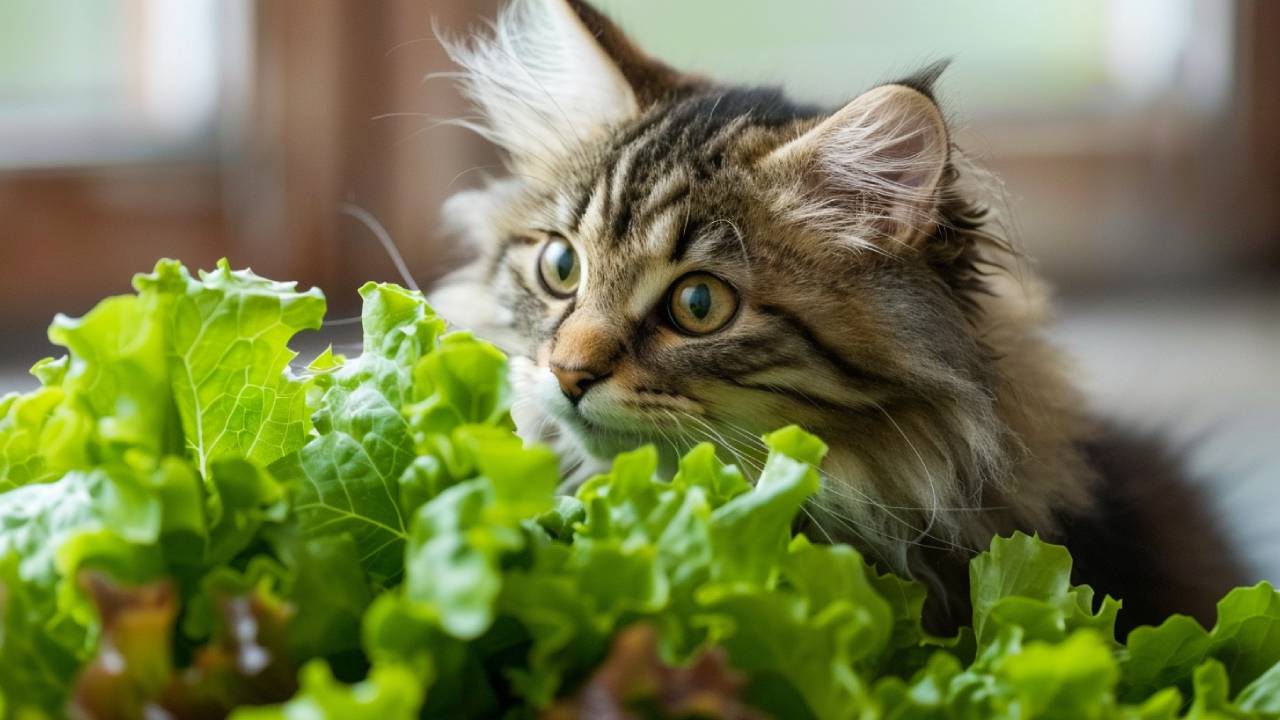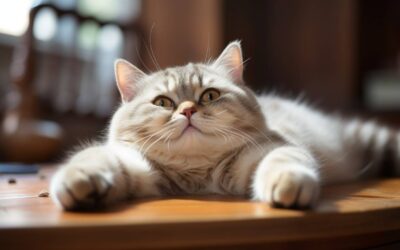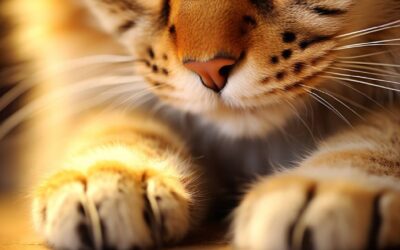Crisp, green, and often a staple in our salads—lettuce is the quintessential veggie that’s hard to ignore. But before you toss a piece to your feline friend, have you ever paused to wonder, can cats really eat lettuce?
It’s a valid question, especially considering cats are obligate carnivores designed to hunt and digest meat. This article dives into the details of this question, offering cat owners or people who will become pet parents soon a well-rounded look at the potential of lettuce as part of a cat’s diet.
Is Lettuce Good for Cats?
Lettuce is not toxic to cats. Lettuce, predominantly water, is low in calories and nutrients but does contain small amounts of fiber and vitamins such as vitamin K, A, and folate. These components are not inherently harmful to cats, suggesting that lettuce isn’t a dangerous food.
However, some cats may have digestive sensitivities or allergies that could lead to gastrointestinal upset when they consume unfamiliar foods, including lettuce.
If you’re looking to bring a new kitten into your home, choosing the right companion is crucial. Not only do you need to think about the best diet for them, but also which kitten might best fit your lifestyle. Explore our kittens for sale page to find your perfect match who will love everything from romaine to playtime.
Which Types of Lettuce Are Safe for Cats?
Lettuce is rather bland and lacks the strong flavors and aromas that attract cats to their food. However, there can be exceptions. Some cats might show interest in lettuce due to its texture or the novelty of a new object in their environment.
Not all types of lettuce are created equal regarding feline consumption. In the following list, we`ve curated safe lettuce types for cats’ health:
Romaine lettuce (is considered one of the safer options for cats)
Green leaf lettuce (another variety that can be a safer choice for cats). It’s similar in texture and flavor to romaine lettuce and, when offered in moderation, is unlikely to cause digestive issues.
While common in salads, iceberg lettuce is not the best choice for your cat. It has a high water content and is less nutritious than other lettuce varieties. Its rugged, fibrous texture can be challenging for cats to digest, potentially leading to gastrointestinal discomfort.
Benefits of Lettuce Feeding
Here are some possible advantages of feeding your cat lettuce;
- Fiber: lettuce contains dietary fiber, which can aid in digestion and help prevent constipation in some cats. Fiber can also promote a feeling of fullness, which might help weight management in overweight cats.
- Chewing and play: lettuce can serve as a non-toxic, low-calorie source of entertainment for your cat. Chewing on lettuce leaves can engage their jaws and provide mental stimulation. Additionally, providing a cat tree in your home can offer a fun and safe space for your cat to climb, scratch, and play, which is another excellent way to keep them active and healthy.
- Vitamins and minerals: lettuce contains essential vitamins and minerals like vitamins K, A, and potassium. While cats can get most of these nutrients from their regular cat food, the small amounts found in lettuce can contribute to their overall nutritional intake.
- Variety in diet: Offering your cat a variety of foods, including occasional lettuce treats, can make mealtime more exciting and enjoyable for them. Like humans, cats can appreciate different tastes and textures in their diet.
Risks of Eating Lettuce
While lettuce is generally safe for cats in small amounts, there are several potential risks that cat owners should be aware of before incorporating it into their pet’s diet. It’s important to understand these risks to ensure that your feline friend enjoys their greens safely.
1. Digestive Issues
Although lettuce is high in fiber, which can be beneficial for digestion, too much fiber can have the opposite effect, leading to digestive distress. Cats have delicate digestive systems that are primarily adapted to handle meat, so introducing significant amounts of plant material can lead to:
- Diarrhea
- Gastrointestinal upset
- Vomiting
Introduce lettuce slowly and in very small amounts into your cat’s diet to assess its ability to digest it without adverse effects.

2. Nutritional Imbalance
Lettuce is low in calories and does not provide the range of nutrients that cats need to maintain their health. Feeding your cat large quantities of lettuce or replacing their regular cat food with lettuce can lead to nutritional deficiencies.
Ensure that lettuce or any vegetable supplements are only a small part of the diet, not a substitute for nutritionally balanced cat food.
3. Allergic Reactions
Although rare, some cats can be allergic to certain types of vegetables or the specific pesticides used on them. Signs of an allergic reaction include:
- Itching or excessive grooming
- Swelling
- Difficulty breathing
Tip: Monitor your cat closely for any signs of an allergic reaction, especially when introducing any new food into their diet. Ensuring you have cat insurance can help manage any unexpected veterinary bills that may arise from such incidents.
How to Give Lettuce to Cat Safely
Lettuce should be an occasional treat, not a dietary staple. Offering small, bite-sized pieces as an infrequent snack is the safest way to introduce lettuce into your cat’s diet. Here are some guidelines to ensure the safe consumption of lettuce by your feline friend:
- Wash thoroughly (to remove any pesticides, chemicals, or contaminants)
- Mix with other foods (mix small pieces of lettuce with your cat’s food) This can be a way to introduce the taste of lettuce without making it the main meal component.
- Freeze small lettuce pieces. Some cats might enjoy licking or playing with small, frozen lettuce pieces in hot weather. This can be a fun and refreshing treat.
The relationship between cats and lettuce is complex. While lettuce isn’t toxic to cats and can be safely offered as an occasional treat, it’s crucial to understand your feline friend’s preferences and dietary needs.
The key is prioritizing your cat’s health and well-being by providing them with the nutrition they need to thrive. And when it comes to sharing a bit of lettuce with your feline friend, do so in a way that respects their preferences and dietary requirements. Your cat will thank you for the love and care you provide.

FAQs
What percentage of a cat’s diet can safely consist of lettuce?
Lettuce should constitute a very small portion of a cat’s diet, ideally less than 5%. It should be considered more of a treat rather than a regular dietary component.
Can offering this vegetable help with my cat’s hydration?
Yes, offering small amounts of lettuce can help keep your cat hydrated due to its high water content. This can be especially useful during warmer weather when cats are at a higher risk of dehydration. However, always ensure fresh water is readily available as the primary source of hydration.
How can I tell if my cat enjoys lettuce?
Cats may nibble on lettuce out of curiosity rather than enjoyment. Observe if your cat repeatedly goes back for more lettuce over different instances rather than just sniffing or licking it once. Consistent interest usually indicates enjoyment, whereas a single interaction might just be curiosity.
Could feeding it to a cat with kidney disease be beneficial?
While the high water content in lettuce might seem beneficial for a cat with kidney disease by aiding hydration, it’s essential to consult with a veterinarian. They can provide guidance based on your cat’s specific health needs and dietary requirements.
Are there any types or parts of the lettuce that should be avoided?
The base of the lettuce, where it attaches to the root, can be tougher and more difficult for cats to chew and digest. It’s best to provide the leafy parts, which are softer and easier to handle. Additionally, avoid seasoned or dressed lettuce, as spices and dressings can contain ingredients that are harmful to cats.
References:
For more detailed insights into the nutritional needs and health management of your cat, consider exploring the following resources:
- Your Cat’s Nutritional Needs: A Science-Based Guide For Pet Owners – This guide provides a thorough overview of what nutrients are crucial for your cat’s diet and why they are important, helping you make informed decisions about your cat’s health.
- Role of Diet in the Health of the Feline Intestinal Tract – Understand how diet influences your cat’s digestive health and the potential impacts of different types of foods, including lettuce.
- Feline Nutrition Part 1: How to Choose the Purr-fect Diet for Your Cat – This article offers practical advice on selecting the right diet for your cat, emphasizing the balance between treats like lettuce and essential nutritional needs.
- Necessary Nutrients for Cats— Explains what nutrients your cat cannot live without and how you can ensure their diet is complete and balanced.






0 Comments